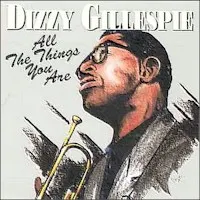Time: 37:29
Size: 85.8 MB
Styles: Bop, Trumpet jazz
Year: 1994/2010
Art: Front
[2:58] 1. All The Things You Are
[3:00] 2. Dizzy Atmosphere
[3:11] 3. Shaw' Nuff
[3:08] 4. Melancholy Baby
[3:05] 5. On The Alamo
[3:21] 6. Emanon
[3:03] 7. Cherokee
[3:11] 8. Blue 'n Boogie
[3:07] 9. One Bass Hit 1
[3:15] 10. A Handfulla Gimme
[2:51] 11. That's Earl Brother
[3:13] 12. I Waited For You
Dizzy Gillespie's contributions to jazz were huge. One of the greatest jazz trumpeters of all time (some would say the best), Gillespie was such a complex player that his contemporaries ended up copying Miles Davis and Fats Navarro instead, and it was not until Jon Faddis' emergence in the 1970s that Dizzy's style was successfully recreated. Somehow, Gillespie could make any "wrong" note fit, and harmonically he was ahead of everyone in the 1940s, including Charlie Parker. Unlike Bird, Dizzy was an enthusiastic teacher who wrote down his musical innovations and was eager to explain them to the next generation, thereby insuring that bebop would eventually become the foundation of jazz. ~Scott Yanow
All The Things You Are









